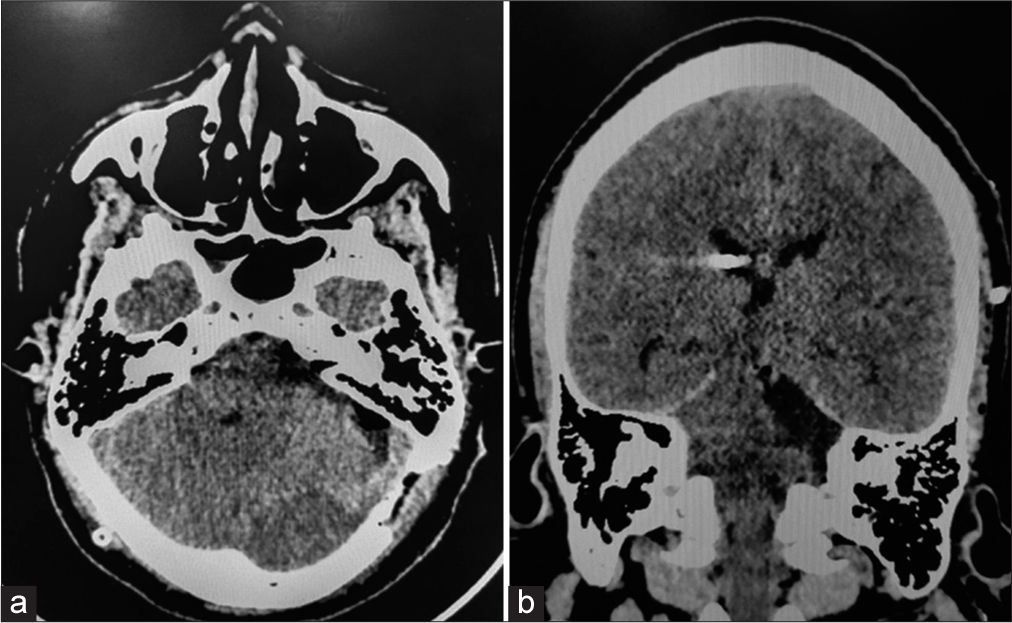- Department of Neurosurgery, All India Institute of Medical Sciences, Raipur, Chhattisgarh, India
- Department of Pediatrics, All India Institute of Medical Sciences, Raipur, Chhattisgarh, India
Correspondence Address:
Charandeep Singh Gandhoke, Department of Neurosurgery, All India Institute of Medical Sciences, Raipur, Chhattisgarh, India.
DOI:10.25259/SNI_673_2024
Copyright: © 2024 Surgical Neurology International This is an open-access article distributed under the terms of the Creative Commons Attribution-Non Commercial-Share Alike 4.0 License, which allows others to remix, transform, and build upon the work non-commercially, as long as the author is credited and the new creations are licensed under the identical terms.How to cite this article: Lanjewar PT1, Tripathi M1, Syal SK2, Singh BK1, Anjankar S1, Gandhoke CS1. Pathological laughter as an unusual first-presenting symptom of petroclival meningioma. Surg Neurol Int 15-Nov-2024;15:420
How to cite this URL: Lanjewar PT1, Tripathi M1, Syal SK2, Singh BK1, Anjankar S1, Gandhoke CS1. Pathological laughter as an unusual first-presenting symptom of petroclival meningioma. Surg Neurol Int 15-Nov-2024;15:420. Available from: https://surgicalneurologyint.com/?post_type=surgicalint_articles&p=13225
Dear Editor,
Pathological laughter is described as a sudden outburst of uncontrollable, spontaneous, and inappropriate laughter when a subjective feeling of euphoria is ruled out.[
We report a case of a 42-year-old male who presented with complaints of pathological laughter for 6 weeks followed by headache, unsteady gait, weakness in the left upper and lower limbs, and difficulty in swallowing liquids for 15–20 days. On examination, his mental status was normal. He had a Glasgow Coma Scale score of 15/15 with left upper and lower limb power of 4/5 and pathological laughter. He had grade 2 facial weakness with an absent gag reflex. Cerebellar signs were positive. Preoperative contrast-enhanced magnetic resonance imaging of the brain revealed a well-defined globular extra-axial lesion in the left petroclival region, which was T1 isointense, T2 iso to hyperintense, measuring 3.5 × 4.2 × 4.0 cm with homogenous postcontrast enhancement [
Pathological laughter has been reported in lesions causing anterior and anterolateral compression and distortion of the upper brainstem. The etiopathogenesis for pathological laughter in our case can be postulated as follows:
Compression of the pontomesencephalic brainstem and its distortion.[ Disinhibition of the fibers from the primary motor area passing through the cerebral peduncles ventrally to reach and inhibit the periaqueductal gray matter and reticular formation in the dorsal mesencephalon.[ Deafferentation of the cerebellum from cortical (prefrontal and cingulate cortices) and subcortical inputs (hypothalamus and brainstem serotonergic raphe nuclei).[ Interference with serotonergic neurotransmission due to lesions of the raphe nuclei.[
We have reported this case to highlight the significance of pathological laughter as an early localizing symptom for petroclival meningioma and its complete resolution after surgery.
Ethical approval
Institutional Review Board approval is not required.
Declaration of patient consent
The authors certify that they have obtained all appropriate patient consent.
Financial support and sponsorship
Nil.
Conflicts of interest
There are no conflicts of interest.
Use of artificial intelligence (AI)-assisted technology for manuscript preparation
The authors confirm that there was no use of artificial intelligence (AI)-assisted technology for assisting in the writing or editing of the manuscript and no images were manipulated using AI.
Disclaimer
The views and opinions expressed in this article are those of the authors and do not necessarily reflect the official policy or position of the Journal or its management. The information contained in this article should not be considered to be medical advice; patients should consult their own physicians for advice as to their specific medical needs.
References
1. Adams RD, Victor M, Ropper AH, Adams RD, Victor M, editors. The limbic lobes and the neurology of emotion. Principles of neurology. New York: McGraw Hill; 1997. p. 508-21
2. Anderson G, Ingeman-Nielsen M, Vestergaard K, Riis JO. Pathoanatomic correlation between poststroke pathological crying and damage to brain areas involved in serotonergic neurotransmission. Stroke. 1994. 25: 1050-2
3. Bhatjiwale MG, Nadkarni TD, Desai KI, Goel A. Pathological laughter as a presenting symptom of massive trigeminal neuromas: Report of four cases. Neurosurgery. 2000. 47: 469-71
4. Gosal JS, Pandey S, Das KK, Khatri D, Rangari K, Jaiswal AK. Pathological laughter as an early and unusual presenting symptom of petroclival meningioma: A case report and review of the literature. World Neurosurg. 2019. 123: 161-4
5. Muzumdar D, Agrahar P, Desai K, Goel A. Pathological laughter as a presenting symptom of petroclival meningioma-case report. Neurol Med Chir (Tokyo). 2001. 41: 505-7
6. Parvizi J, Anderson SW, Martin CO, Damasio H, Damasio AR. Pathological laughter and crying: A link to the cerebellum. Brain. 2001. 124: 1708-19
7. Shafqat S, Elkund MS, Chiocca EA, Takeoka M, Koroshetz WJ. Petroclival meningioma presenting with pathological laughter. Neurology. 1998. 50: 1918-9
8. Wild B, Rodden FA, Grodd W, Ruch W. Neural correlates of laughter and humor. Brain. 2003. 126: 2121-38







